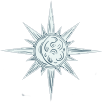Samudrika Shastra is an ancient Indian science that analyzes the physical features of the human body to interpret personality traits, behavior, and even destiny. It is an integral part of Vedic traditions and is often used in conjunction with astrology (Jyotish) and palmistry (Hasta
Rekha Vigyan).
The term "Samudrika" comes from the Sanskrit words:
• Samudra (meaning "ocean" or "universal")
• Shastra (meaning "science" or "knowledge").
Thus, Samudrika Shastra translates to "the science of universal (human) characteristics."
Scope of Samudrika Shastra
Samudrika Shastra is a holistic science that examines:
1. Face reading (Mukha Lakshana)
2. Hand and palm reading (Hasta Rekha Vigyan)
3. Foot reading (Pada Samudrika)
4. Body structure and features (Anga Lakshana)
Every feature of the body, including its shape, size, and texture, is believed to hold symbolic meanings tied to the person's personality, fate, and life journey.
Key Aspects of Samudrika Shastra
1. Face Analysis (Mukha Lakshana)
o Forehead: A broad forehead symbolizes intelligence and wisdom, while a narrow one may suggest a reserved personality.
o Eyes: Large, bright eyes indicate a kind and creative nature, while small eyes reflect focus and practicality.
o Nose: A straight, well-defined nose suggests leadership qualities, whereas a curved nose may indicate a strategic and diplomatic mindset.
o Mouth and Lips: Well-shaped lips reflect a balanced nature, while thin lips may signify sharpness and determination.
2. Hands and Palm Reading
o The size, texture, and lines on the palm reveal aspects of health, wealth, relationships, and career.
o Fingers and nails are studied to understand detailed personality traits.
3. Body Structure (Anga Lakshana)
o Head: A well-proportioned head symbolizes intelligence and a balanced personality.
o Shoulders: Broad shoulders indicate strength and responsibility, while sloped shoulders may reflect a laid-back attitude.
o Chest and Torso: A strong, broad chest is a sign of confidence and courage.
4. Foot Analysis (Pada Samudrika)
o The shape, color, and texture of the feet are associated with an individual’s spiritual and material journey.
o Soft, smooth feet are considered auspicious, while rough or cracked feet may indicate struggles.
5. Voice Analysis
o A clear, melodious voice suggests kindness and charm, while a harsh or loud voice may reflect aggression or dominance.
Philosophical Foundation
Samudrika Shastra is deeply rooted in the belief that the microcosm (the body) reflects the macrocosm (the universe). The human body is seen as a map that mirrors a person’s karma (actions), gunas (qualities), and samskaras (impressions from past lives).
This knowledge is derived from ancient texts like:
• Brihat Samhita by Varahamihira
• Various Puranas and Vedic scriptures
Applications of Samudrika Shastra
1. Character Assessment: Understanding personality traits and tendencies.
2. Compatibility Analysis: Used in matchmaking to assess compatibility in relationships.
3. Health and Longevity Predictions: Insights into physical and emotional health.
4. Career and Life Guidance: Identifying strengths and weaknesses for success.
5. Spiritual Growth: Understanding one's karmic influences and spiritual potential.
Modern Relevance
While Samudrika Shastra is considered a traditional science, its principles are still applied in various forms of psychological and personality analysis. However, it is essential to view it as a complementary tool rather than a definitive guide to life.
If you'd like to explore a specific part of Samudrika Shastra, such as facial features, hands, or body analysis, let me know!

